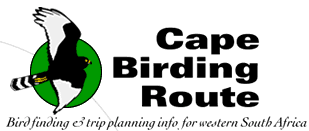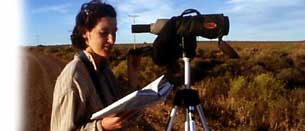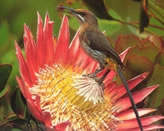West
Coast National Park:
|

Click
on Map to Enlarge
|
The
still, aquamarine waters of the sheltered, 16-km long
Langebaan Lagoon, the jewel of the West Coast, provide
excellent birding. Granite inselbergs rise sharply from
its northern shores, while South Africa’s largest
saltmarsh lies at its southern end. The West Coast National
Park has become a legendary birding site, best known
for the large numbers of migrant waders that crowd the
mudflats during summer. These can easily be observed
from the well-positioned bird hides, offering local
birders an excellent chance of finding rarities. The
top-class strandveld birding, spring flowers and proximity
to Cape Town (taking the direct route along the R27,
it is less than an hour from the city) all make the
West Coast National Park a most productive, pleasant,
and accessible birding destination.
|

Marsh Sandpiper occurs at 1 on the Map |
Approaching
from the south along the R27, the well-marked turn-off to
the West Coast National Park is 10.9 km beyond the R315 Yzerfontein/Darling
junction. An entrance fee, which includes a map and birdlist,
is payable at the gate. A meandering tar road leads northwards
into the park, passing through some excellent strandveld.
Roadside birding in the park is highly rewarding. Ostrich
are readily seen, resembling giant prehistoric reptilians
rather than birds as they stride across the vegetated dunes.
Cape Francolin is very common throughout the reserve,
and coveys of the smaller and scarcer Grey-wing Francolin
should be carefully searched for on the road edges in the
early morning and evening. Black
Harrier (p.57*) may be seen quartering low over the
vegetation anywhere in the park. Black-shouldered Kite
prefer roadside perches, and many roost communally at night
in the large reedbeds on the eastern side of the lagoon, after
gathering in one of the lonely palms trees in this area. Flocks
of Pied and Wattled Starlings occur throughout
the park. Southern
Black Korhaan (p.57*) is regularly seen at the roadside,
especially between Geelbek and the park’s northern exit
near Langebaan village.
Because
the vegetation is so dense, visitors are unlikely to see many
of the mammals that occur here. Two small antelope, Common
Duiker (Sylvicapra grimmia) and Steenbok (Raphicerus
campestris), are often startled at the road edges (especially
in the early morning), giving a brief view of themselves before
darting back into the vegetation. The peculiar tortoise roadsigns
along this route refer to Angulate Tortoises (Chersina
angulata), which are commonly seen crossing the park roads.
The
strandveld vegetation throughout the park harbours species
such as White-backed Mousebird, Karoo Lark,
Cape Penduline
Tit, Cape Bulbul, Cape Robin, Karoo
Robin, Titbabbler, Layard’s Titbabbler,
Grey-backed Cisticola, Long-billed Crombec,
Bar-throated Apalis, Grassbird, Bokmakierie,
Lesser Double-collared Sunbird, Malachite Sunbird,
Cape Weaver, White-throated Canary, Yellow
Canary and Cape Bunting.
Check
for Pearl-breasted Swallow among the flocks of commoner
European and White-throated Swallows.
The
Geelbek mudflat bird hide (1 on site map overleaf) allows
for superb wader watching in summer, and is arguably South
Africa’s best waterbird hide. The array of desirable
vagrant waders that have been found here over the last few
years (see p.50) render it the favoured haunt of dedicated
twitchers such as Trevor Hardaker, who make the pilgrimage
here with fanatical regularity. It allows for close-up views
of a large diversity of wading species; common summer migrants
include Curlew Sandpiper, Little Stint, Sanderling,
Knot, Turnstone, Greenshank, Marsh
Sandpiper (unusually common here), Whimbrel, Grey
Plover, Ringed Plover, Bar-tailed Godwit,
and a smaller number of resident White-fronted and
Chestnut-banded Plovers. A few of the localized Curlew
are always present, and it usually takes some careful scanning
to pick up the scarce but regular Terek Sandpiper and,
with luck, Greater Sandplover or Redshank.
Timing
is very important: the area is at its most rewarding on the
correct part of the tidal cycle. This is notoriously difficult
to predict, although the best viewing usually begins about
4.5 hours after the ‘High tide in Table Bay’ as
listed in Cape Town newspapers. At about this time, the water
drops and slowly begins to expose the mud and its invertebrates
on the surface. The longer-legged waders land first, soon
to be joined by the smaller species as the water recedes further
still. If you get the timing wrong, try the Seeberg hide (opposite),
which is better at high tide, or console yourself with the
view of the distant white cliffs of the lagoon’s western
shore. These were recently in the international limelight
when the most ancient of recorded Homo sapiens footprints
were discovered here (having lain preserved in rock for the
past 117 000 years).
A
wide variety of other waterbirds may be seen from the hide,
including South African Shelduck. African Rail
is regularly seen darting in and out of the sedges, especially
in the early morning on the right-hand side of the hide. African
Marsh Harrier breeds in the adjacent reedbeds, and Osprey
passes overhead in summer. The approach to the hide is by
way of a wooden boardwalk that serves to protect a splendid
tract of multicoloured saltmarsh. This endangered vegetation
type is very sensitive to disturbance and takes many years
to recover from damage from trampling. Check the small pools
here for Kittlitz’s Plover, Black-winged Stilt,
Blacksmith Plover and Cape Wagtail. Noisy Levaillant’s
Cisticola, African Sedge Warbler and Cape Reed
Warbler occur in the adjacent reedbeds.

Cape
Francolin are common in the Park
|
The
Geelbek manor house (2 on map), restored in the typical
Cape Dutch style, has a small restaurant with tame Cape
Francolins and Cape Weavers in attendance.
Acacia Pied Barbet, Titbabbler and the
occasional Cardinal Woodpecker frequent the stands
of largely alien trees. A further two bird hides (and
another in preparation, sponsored by the Cape Bird Club)
are located at a pan on the edge of a vast saltmarsh
(3), a 20-minute walk from the manor house.
Starting at the parking area, it passes through old
farmlands where Thick-billed Lark, Levaillant’s
(near water) and Grey-backed Cisticolas, Stonechat
and Cape Sparrow are common. The number of birds
on this saltpan depends on the water level, and on the
state of the tide; high tide is best, as many birds
roost here when forced off their mudflat feeding grounds.
|
The
Geelbek manor house (2 on map), restored in the typical Cape
Dutch style, has a small restaurant with tame Cape Francolins
and Cape Weavers in attendance. Acacia Pied Barbet,
Titbabbler and the occasional Cardinal Woodpecker
frequent the stands of largely alien trees. A further two
bird hides (and another in preparation, sponsored by the Cape
Bird Club) are located at a pan on the edge of a vast saltmarsh
(3), a 20-minute walk from the manor house. Starting at the
parking area, it passes through old farmlands where Thick-billed
Lark, Levaillant’s (near water) and Grey-backed
Cisticolas, Stonechat and Cape Sparrow are
common. The number of birds on this saltpan depends on the
water level, and on the state of the tide; high tide is best,
as many birds roost here when forced off their mudflat feeding
grounds. Mainly smaller waders occur here, including large
numbers of Little Stint. When water levels are low,
White-fronted, Chestnut-banded and Kittlitz’s
Plovers are often common. Small groups of Caspian Plover,
a species unknown elsewhere in the Cape, have in recent years
regularly been seen in this vicinity. Keep a look out overhead
for Peregrine Falcon, which consistently harass the
waders.
On
the road to Langebaan village, the Seeberg lookout (4) can
be seen perched on a granite hillock, and provides a panoramic
view of the lagoon. It is worth scanning for Black
Harrier (p.57*) in this vicinity. The granite boulders
below are home to a group of dassies (Rock Hyrax Procavia
capensis). The viewsite is reached by a short, unsurfaced
road that is probably the best place in the park to look for
Southern
Black Korhaan (p.57*). This small bustard is often
seen at close quarters in the open areas near the viewsite
parking area, especially in the morning and evening. Also
look out for Grey-wing Francolin.
The
short road down to the Seeberg hide (5) offers good strandveld
birding, and is covered with flowers during spring. The low
ridge of dunes on the right, about 100 m down the road, is
home to a covey of Grey-wing Francolin, which are almost
always found in this vicinity. Most of the strandveld species
can be seen at the parking area near the hide, including Cape
Penduline Tit (p.81) and Layard’s Titbabbler.
Although the Seeberg hide is not as well situated as that
at Geelbek, it offers a good selection of waders and terns,
especially at high tide. Large numbers of Bar-tailed Godwit
may be seen here, and Little Tern often roosts on the
closest sandbank.
Abrahamskraal
waterhole (6) is one of the only sources of fresh water in
the park, and many birds come here to drink, including Namaqua
Dove, Wattled Starling, White-throated and
Yellow Canaries, and Cape Bunting. Cape Reed
Warbler, African Sedge Warbler and Levaillant’s
Cisticola are common and easily seen in the reeds, while
Black Crake skulks lower down at the reed bases. A
variety of widespread waterbirds also occur here, including
African Spoonbill, Moorhen and Three-banded
Plover. Brown-throated Martin hunts overhead.
The
viewsite at 7 offers not only panoramic views over the lagoon
and sea, but is a good spot to look for Karoo Lark.
The northwestern Postberg section of the park (8) is open
only during the flower season (August to October). Dominated
by sloping meadows strewn with granite boulders, this part
of the reserve offers spectacular scenery, excellent flower
viewing, pleasant birding and a variety of introduced game
species, including Gemsbok (Oryx gazella) and Springbok
(Antidorcas marsupialis). There is year-round access
to the sea at Tsaarsbank (at 9, outside the Postberg section),
where African
Black Oystercatcher (p.32*) and Cape, White-breasted
and Crowned Cormorants occur on the rocks. Cape
Gannet and White-chinned Petrel can often be seen
offshore.
|


